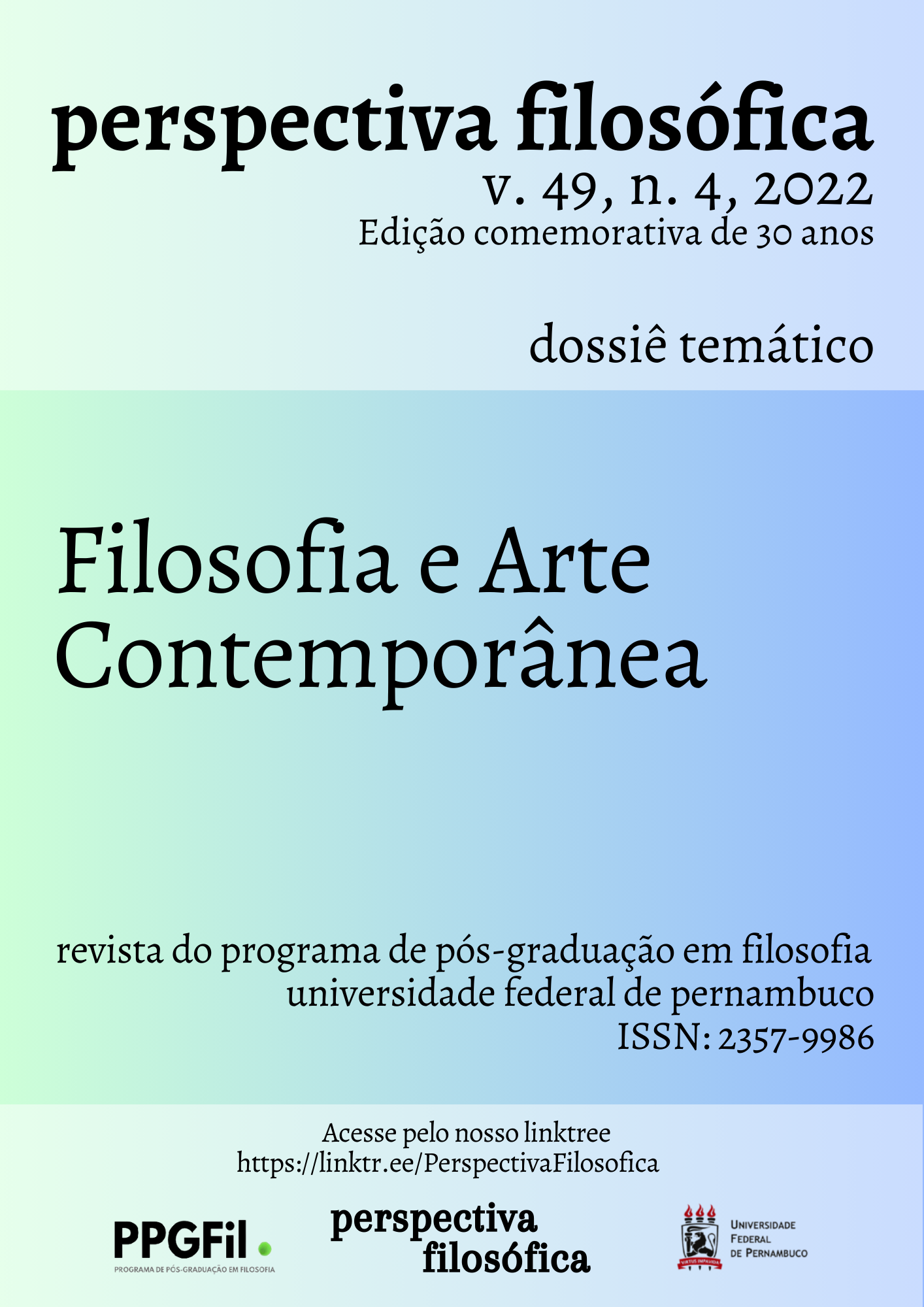Mais real que a realidade? Heidegger e Cavell sobre os poderes de absorção do filme
DOI:
https://doi.org/10.51359/2357-9986.2022.256179Palavras-chave:
Cavell, ceticismo, Heidegger, mundo como image, tecnologiaResumo
O poder das imagens (paradas e em movimento) de nos absorver às vezes as faz parecer mais reais do que a realidade. Seguindo os passos de Martin Heidegger e Stanley Cavell, este artigo tenta dar sentido histórico e filosófico a esse sentimento, remontando-o a mudanças de época em nossa experiência que começaram com o advento da modernidade. Depois de destacaras implicações e os custos dessas mudanças, aponto para formas alternativas de relação com a realidade que ainda estão disponíveis para nós, e argumento que (alguns) filmes podem ajudar a abri-las.
Referências
ABBOTT, Matthew. Abbas Kiarostami and Film-Philosophy. Edinburgh: Edinburgh University Press, 2016.
BAUDRILLARD, Jean. The Perfect Crime. Tradução: Chris Turner. London / New York: Verso Books,1996.
BAZIN, André. What Is Cinema? Vol. 1. Hugh Gray (trans.). Berkeley and Los Angeles: University of California Press, 1967.
BENJAMIN, Walter. Selected Writings: 1935-1938. Cambridge, MA: Harvard University Press, 1996.
BENJAMIN, Walter. One-Way Street. Tradução: Edmund Jephcott. Cambridge, MA: Harvard University Press, 2016. Disponível em: http://ebookcentral.proquest.com/lib/nyulibrary-ebooks/detail.action?docID=4510802. Acesso em 14 Abr. 2021.
BORGMANN, Albert. Crossing the Postmodern Divide. Chicago and London: The University of Chicago Press, 1993.
CAVELL, Stanley. Must We Mean What We Say?, Cambridge: Cambridge University Press, 1976.
CAVELL, Stanley. The World Viewed: Reflections on the Ontology of Film (Enlarged Edition). Cambridge, MA: Harvard University Press, 1979.
CAVELL, Stanley (1987). Disowning Knowledge: In Six Plays of Shakespeare. Cambridge: Cambridge University Press.
KELLNER, Douglas. “Jean Baudrillard”. The Stanford Encyclopedia of Philosophy, Winter 2020 Edition, Edward N. Zalta (ed.), 2020. Disponível em: https://plato.stanford.edu/archives/win2020/entries/baudrillard/. Acesso em Abr. 2021.
KISIEL, Theodor. “Heidegger and Our Twenty-first Century Experience of Ge-Stell”. In: B. Babich and D. Ginev (eds.), The Multidimensionality of Hermeneutic Phenomenology, Contributions to Phenomenology 70, DOI 1007/978-3-319-01707-5_9 Switzerland: Springer International Publishing, 2014.
LOHT, Shawn. “Film as Heideggerian Art? A Re-Assessment of Heidegger, Film, and His Connection to Terrence Malick.” In: Film and Philosophy 17: p. 113-36, 2013.
LOHT, Shawn. Phenomenology of Film: A Heideggerian Account of the Film Experience. Lanham, MD: Lexington Books, 2017.
MOSELY, Michael Josiah. “Another Look at Heideggerian Cinema: Cinematic Excess, Antonioni's Dead Time and the Film-Photographic Image as Copy”. In: Film-Philosophy 22:3, pp. 364-383, 2018.
ROJCEWICZ, Richard. The Gods and Technology: A Reading of Heidegger.
Albany, NY: State University of New York Press, 2006.
SINNERBRINK, Robert. “Techne and Poiesis: On Heidegger and Film Theory”. In A. van den Oever (Ed.), Techne/Technology: Researching Cinema and Media Technologies – Their Development, Use, and Impact (pp. 65–. Amsterdam: Amsterdam University Press, 2014.
SONTAG, Susan. On Photography. New York: Farrar, Straus and Giroux,
RUSHTON, Richard. The reality of film: Theories of filmic reality. Manchester and New York: Manchester University Press, 2011.
HEIDEGGER, Martin. Discourse on Thinking. Tradução: John M. Anderson e E. Hans Freund. New York: Harper & Row, 1966.
HEIDEGGER, Martin. What Is Called Thinking? Tradução: J. Glenn Gray e Fred D. Wieck. New york: Harper Torchback, 1972.
HEIDEGGER, Martin. The Question concerning Technology, and Other Essays. New York: Harper & Row, 1977.
HEIDEGGER, Martin. On the Way to Language. Tradução: P. D. Hertz. New York: Harper & Row, 1982.
HEIDEGGER, Martin. An Introduction to Metaphysics. Tradução: Gregory Fried e Richard Polt. New Haven: Yale University Press, 2000.
HEIDEGGER, Martin. Poetry, Language, Thought. Tradução: Albert Hofstadter. New York: HarperCollins, 2001.
HEIDEGGER, Martin. Off the Beaten Track. Cambridge, MA: Cambridge University Press, 2002.
HEIDEGGER, Martin. Heraclitus: The Inception of Occidental Thinking and Logic: Heraclitus’s Doctrine of the Logos. Tradução: Julia Goesser Assaiante e S. Montgomery Ewegen. London and New York: Bloomsbury Publishing, 2018.
TECHIO, Jônadas. “Can film show what (analytic) philosophy won't say? The “film as philosophy” debate, and a reading of Rashomon”. Revista Dissertatio de Filosofia, v. 6, p. 69-105, 2018.
TECHIO, Jônadas. “The world viewed and the world lived: Stanley Cavell and film as the moving image of skepticism”. In: Christina Rawls, Diana Neiva, Steven S. Gouveia (Eds.), Film and Philosophy: Bridging Divides. Routledge, 2019.
TECHIO, Jônadas. “Mourning the Loss of the Ordinary: A Cavellian Reading of Ozu's Late Spring”. Aesthetic Investigations, v. 3, 2020.
WITTGENSTEIN, Ludwig. The Blue and Brown Books. Oxford: Basil Blackwell, 1958.
WOESSNER, Martin. “What Is Heideggerian Cinema? Film, Philosophy, and Cultural Mobility”. In New German Critique 113, Vol. 38, No. 2, Summer 2011.
Downloads
Publicado
Edição
Seção
Licença
A Revista Perspectiva Filosófica orienta seus procedimentos de gestão de artigos conforme as diretrizes básicas formuladas pelo Conselho Nacional de Desenvolvimento Científico e Tecnológico (CNPq). http://www.cnpq.br/web/guest/diretrizesAutores que publicam nesta revista concordam com os seguintes termos:
Os autores mantém os direitos autorais e concedem à revista o direito de primeira publicação, sendo o trabalho simultaneamente licenciado sob https://creativecommons.org/licenses/by/4.0/deed.pt_BR que permite o compartilhamento do trabalho com reconhecimento da autoria e publicação inicial nesta revista.
Os autores têm autorização para assumir contratos adicionais separadamente, para distribuição não-exclusiva da versão do trabalho publicada nesta revista, com reconhecimento de autoria e publicação inicial nesta revista (Consultar http://opcit.eprints.org/oacitation-biblio.html).

Esta revista está licenciada com uma Licença Creative Commons Atribuição 4.0 Internacional.













